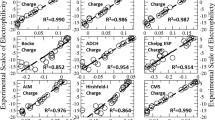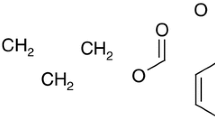Abstract
Predicting the reactivity of nucleophilic reaction at different sites has important theoretical and practical significance. Many prediction methods solely based on the electronic structure of reactants have been proposed. In this paper, detailed comparative analyses on the reliability of 14 methods are carried out and three series of molecules, carbonyl compounds, aromatic hydrocarbons and pyridine derivatives are exploited as test systems. It is found that the methods reflecting local electronic softness, such as condensed dual descriptor, have satisfactory prediction ability; while the ones reflecting electrostatic effect, such as atomic charge analysis and electrostatic potential analysis, have evidently worse overall performance. For all systems of interest, condensed dual descriptor and Hirshfeld charge display the most robust predictive capacity.
Similar content being viewed by others
References
Wade Jr LG. Organic Chemistry. 6th Ed. New Jersey: Pearson Education International, 2006
Cao CZ, Wu YX. Recent progress in quantifying substituent effects. Sci China Chem, 2013, 56: 883–910
Marx D, Hutter J. Ab Initio Molecular Dynamics-Basic Theory and Advanced Methods. Cambridge: Cambridge University Press, 2009
Esteves PM, de M. Carneiro JW, Cardoso SP, Barbosa AGH, Laali KK, Rasul G, Surya Rrakash GK, Olah GA. Unified mechanistic concept of electrophilic aromatic nitration: convergence of computational results and experimental data. J Am Chem Soc, 2003, 125: 4836–4849
Jensen F. Introduction to Computational Chemistry. 2nd Ed. West Sussex: John Wiley & Sons, 2007. 487–492
Parr RG, Yang W. Density functional approach to the frontier-electron theory of chemical reactivity. J Am Chem Soc, 1984, 106: 4049–4050
Morell C, Grand A, Toro-Labbé A. New dual descriptor for chemical reactivity. J Phys Chem A, 2004, 109: 205–212
Sjoberg P, Politzer P. Use of the electrostatic potential at the molecular surface to interpret and predict nucleophilic processes. J Phys Chem, 1990, 94: 3959–3961
Lu T, Chen FW. Comparison of computational methods for atomic charges. Acta Phys Chim Sin, 2012, 28: 1–18
Roy RK. Stockholders charge partitioning technique. A reliable electron population analysis scheme to predict intramolecular reactivity sequence. J Phys Chem A, 2003, 107: 10428–10434
Fu R, Lu T, Chen FW. Comparing methods for predicting the reactive site of electrophilic substitution. Acta Phys Chim Sin, 2014, 30: 628–639
Liu SB. Conceptual density functional theory and some recent developments. Acta Phys Chim Sin, 2009, 25: 590–600
Yang W, Mortier WJ. The use of global and local molecular parameters for the analysis of the gas-phase basicity of amines. J Am Chem Soc, 1986, 108: 5708–5711
Jin JL, Li HB, Lu T, Duan YA, Geng Y, Wu Y, Su ZM. Density functional studies on photophysical properties and chemical reactivities of the triarylboranes: effect of the constraint of planarity. J Mol Model, 2013, 19: 3437–3446
Oláh J, van Alsenoy C, Sannigrahi AB. Condensed Fukui functions derived from stockholder charges: assessment of their performance as local reactivity descriptors. J Phys Chem A, 2002, 106: 3885–3890
Fukui K. Theory of Orientation and Stereoselection. Berlin: Springer, 1970. 1–85
Lu T, Chen FW. Calculation of molecular orbital composition. Acta Chim Sin, 2011, 69: 2393–2406
Roy RK, Krishnamurti S, Geerlings P, Pal S. Local softness and hardness based reactivity descriptors for predicting intra- and intermolecular reactivity sequences: carbonyl compounds. J Phys Chem A, 1998, 102: 3746–3755
Mulliken RS. Electronic population analysis on LCAO-MO molecular wave functions. I. J Chem Phys, 1955, 23: 1833–1840
Breneman CM, Wiberg KB. Determining atom-centered monopoles from molecular electrostatic potentials. the need for high sampling density in formamide conformational analysis. J Comput Chem, 1990, 11: 361–373
Weinhold F. Natural bond orbital methods. In: Schleyer PVR. Encyclopedia of Computational Chemistry. West Sussex: John Wiley & Sons, 1998. 1792–1811
Hirshfeld FL. Bonded-atom fragments for describing molecular charge densities. Theor Chem Acc, 1977, 44: 129–138
Lu T, Chen F. Atomic dipole moment corrected hirshfeld population method. J Theor Comp Chem, 2012, 11: 163–183
Murray JS, Politzer P. The electrostatic potential: an overview. WIREs Comp Mol Sci, 2011, 1: 153–163
Lipkowitz KB, Cundari TR, Boyd DB. Reviews in Computational Chemistry. New York: John Wiley & Sons, 1991. 273–312
Geerlings P, Langenaeker W, De Proft F. Molecular electrostatic potentials vs. DFT descriptors of reactivity. In: Murray JS, Sen K, Eds. Molecular Electrostatic Potentials: Concepts and Applications. Amsterdam: Elsevier Science BV, 1996, 3: 587–617
Politzer P, Murray JS. The fundamental nature and role of the electrostatic potential in atoms and molecules. Theor Chem Acc, 2002, 108: 134–142
Bader RFW, Carroll MT, Cheeseman JR, Chang C. Properties of atoms in molecules: atomic volumes. J Am Chem Soc, 1987, 109: 7968–7979
Lu T, Chen FW. Quantitative analysis of molecular surface based on improved marching tetrahedra algorithm. J Mol Graph Model, 2012, 38: 314–323
Pearson RG. Hard and soft acids and bases. J Am Chem Soc, 1963, 85: 3533–3539
Politzer P, Murray JS. The average local ionization energy: concepts and applications. In: Toro-Labbé A, Ed. Theoretical Aspects of Chemical Reactivity. Amsterdam: Elsevier, 2007. 119–137
Domingo LR, Pérez P, Sáez JA. Understanding the local reactivity in polar organic reactions through electrophilic and nucleophilic Parr functions. RSC Adv, 2013, 3: 1486–1494
Lu T, Chen FW. Meaning and functional form of the electron localization function. Acta Phys Chim Sin, 2011, 27: 2786–2792
Bader RFW, Chang C. Properties of atoms in molecules: electrophilic aromatic substitution. J Phys Chem, 1989, 93: 2946–2956
Murray JS, Peralta-Inga Z, Politzer P, Ekanayaka K, LeBreton P. Computational characterization of nucleotide bases: molecular surface electrostatic proteins and local ionization energies, and local polarization energies. Int J Quantum Chem, 2001, 83: 245–254
Ehresmann B, Martin B, Horn AHC, Clark T. Local molecular properties and their use in predicting reactivity. J Mol Model, 2003, 9: 342–347
Parthasarathi R, Padmanabhan J, Elango M, Subramanian V, Chattaraj PK. Intermolecular reactivity through the generalized philicity concept. Chem Phys Lett, 2004, 394: 225–230
Morell C, Grand A, Toro-Labbé A. New dual descriptor for chemical reactivity. J Phys Chem A, 2005, 109: 205–212
Oláh J, van Alsenoy C, Sannigrahi AB. Condensed Fukui functions derived from stockholder charges: assessment of their performance as local reactivity descriptors. J Phys Chem A, 2002, 106: 3885–3890
Politzer P, Murray JS. Molecular electrostatic potentials and chemical reactivity. In: Lipkowitz KB, Boyd DB, Eds. Reviews in Computational Chemistry. Volume 2. New York: John Wiley & Sons, 1991: 273–312
Wang JT, Hu Q, Zhang B, Wang Y. Organic Chemistry. 2nd Ed. Tianjin: NanKai University Press, 1993
Morrison RT, Boyd RN. Organic Chemistry. 6th Ed. New Jersey: Prentice Hall, Inc., 1992
Smith MB, March J. March’s Advanced Organic Chemistry: Reactions, Mechanisms, and Structure. New York: John Wiley & Sons, 2007
Chupakhin ON, Charushin VN, van der Plas HC. Nucleophilic Aromatic Substitution of Hydrogen. London: Academic Press, 2012
Terrier, François. Modern Nucleophilic Aromatic Substitution. New York: John Wiley & Sons, 2013
Deuri S, Phukan P. A DFT study on nucleophilicity and site selectivity of nitrogen nucleophiles. Comput Theor Chem, 2012, 980: 49–55
Frisch MJ, Trucks GW, Schlegel HB, Scuseria GE, Robb MA, Cheeseman JR, Montgomery JA Jr, Vrevon T, Kudin KN, Burant JC, Millam JM, Iyengar SS, Tomasi J, Barone V, Menucci B, Cossi M, Scalmani G, Rega N, Petersson GA, Nakatsuji H, Hada M, Ehara M, Toyota K, Fukuda R, Hasegawa J, Ishida M, Nakajima T, Honda Y, Kitao O, Nakai H, Klene M, Li X, Knox JE, Hratchian HP, Cross JB, Adamo C, Jaramillo J, Gomparts R, Stratmann RE, Yazyev O, Austin AJ, Cammi R, Pomelli C, Ochterski JW, Ayala PY, Morokuma K, Voth GA, Salvador P, Dannenberg JJ, Zakrzewski VG, Dapprich S, Daniels AD, Strain MC, Farkas O, Malick DK, Rabuck AD, Raghavachari K, Foresman JB, Ortiz JV, Cui Q, Baboul AG, Clifford S, Cioslowski J, Stefanov BB, Liu G, Liashenko A, Piskorz P, Komaromi I, Martin RL, Fox DJ, Keith T, Al-Laham MA, Peng CY, Namayakkara A, Challacombe M, Gill PMW, Johnson B, Chen W, Wong MW, Gonzalez C, Pople JA. Gaussian 03. Version B.02. Wallingford, CT: Gaussian, Inc., 2004
Becke AD. A new mixing of Hartree-Fock and local densityfunctional theories. J Chem Phys, 1993, 98: 1372–1377
Lu T, Chen FW. Multiwfn: a multifunctional wavefunction analyzer. J Comput Chem, 2012, 33: 580–592
Multiwfn website: http://Multiwfn.codeplex.com (accessed on 2014-10-10)
Author information
Authors and Affiliations
Corresponding author
Additional information
Dedicated to Professor Lemin Li on the occasion of his 80th birthday.
Rights and permissions
About this article
Cite this article
Cao, J., Ren, Q., Chen, F. et al. Comparative study on the methods for predicting the reactive site of nucleophilic reaction. Sci. China Chem. 58, 1845–1852 (2015). https://doi.org/10.1007/s11426-015-5494-7
Received:
Accepted:
Published:
Issue Date:
DOI: https://doi.org/10.1007/s11426-015-5494-7




